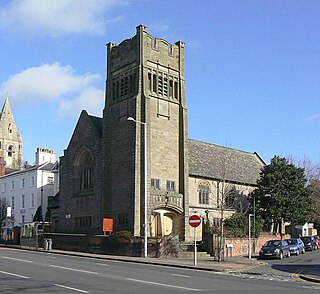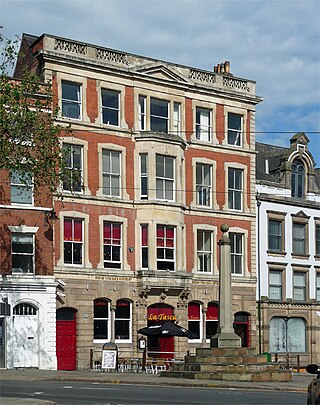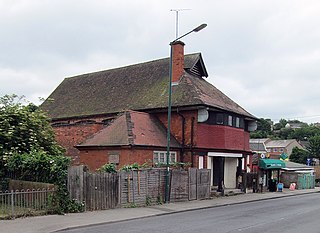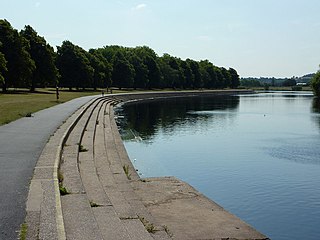
Nottingham Victoria railway station was a Great Central Railway and Great Northern Railway railway station in Nottingham, England. It was designed by the architect Albert Edward Lambert, who also designed the rebuild of the Nottingham Midland station.

Beeston railway station serves the town of Beeston in Nottinghamshire, England. It lies on a spur of the Midland Main Line and is managed by East Midlands Railway. It is situated 3.2 miles (5.1 km) south-west of Nottingham railway station and 750 metres (0.5 mi) south-east of Beeston transport interchange, for local bus services and Nottingham Express Transit trams. The station building is Grade II listed.

Watson Fothergill was a British architect who designed over 100 unique buildings in Nottingham in the East Midlands of England. His influences were mainly from the Gothic Revival and Old English vernacular architecture styles.

St Peter's Church, formally The Church of St Peter with St James, is an Anglican parish church in the city centre of Nottingham, England. It is part of the parish of All Saints', St Mary's and St Peter's, Nottingham.

St. Stephen's Church, Sneinton is a parish church in the Church of England.

Holy Trinity Church, Lenton is a parish church in the Church of England Diocese of Southwell, located in Lenton, Nottingham.

St Columba's Church, Nottingham was an English Presbyterian church in Nottingham, England, built in 1898 and located at the Mansfield Road/Villa Road intersection. It was founded in 1896 as a daughter church of St Andrew's Presbyterian Church, also in Nottingham. The new buildings by Brewill and Baily were started in 1896 and complete by 1900.

William Arthur Heazell FRIBA was an architect based in Nottingham.

The Nottingham and Nottinghamshire Bank was a joint stock bank which operated from its headquarters in Nottingham from 1834 to 1919.

William Jolley was an English architect based in Nottingham.

William Beedham Starr JP was an architect based in Nottingham.

Abraham Harrison Goodall LRIBA was a British architect based in Nottingham.

William Richard Gleave ARIBA was a surveyor and architect based in Nottingham.

Charles Leighfield Jonah Doman FRBS was a sculptor from Nottingham.
Carrington Baptist Church was a Baptist church on Sherbrooke Road, Carrington, Nottingham which was opened in 1883.

Lieut-Colonel Herbert Walker FRIBA, M Inst CE, FSI, was an architect, surveyor and civil engineer based in Nottingham from 1870 to 1923.

Nottingham Central Library is the name given to the main public lending library in Nottingham, England. The library at Angel Row was closed to public in 2020 with the contents placed into storage, contingent upon a new building becoming available. The new building was opened in November 2023, closer to the railway station.

The Nottingham Corporation Electricity Department was responsible for the production and supply of electricity in Nottingham, England, from 1894 to 1948.

Arthur Brown M.Inst. C.E. was City Engineer for Nottingham, England from 1880 to 1919.

The Old Assembly Rooms is a Grade II listed building at 9 Low Pavement, Nottingham.
























